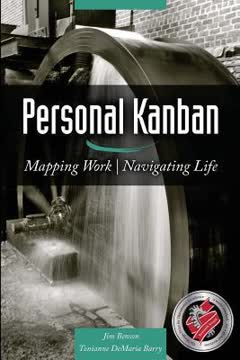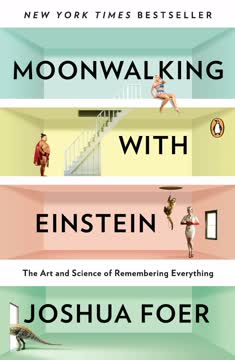Key Takeaways
1. The Inner Game: Overcoming mental interference to reach your full potential
Players of the Inner Game find that when they focus on eliminating mental interference, their outer game performance automatically comes closer to their potential.
Mental interference hinders performance. The Inner Game is based on the principle that our performance (P) is equal to our potential (p) minus interference (i), expressed as P = p - i. This interference often comes from our own minds, in the form of self-doubt, fear, and excessive self-instruction.
Self 1 vs. Self 2. The book introduces the concept of Self 1 and Self 2. Self 1 is our interfering, doubting, and controlling voice, while Self 2 represents our natural abilities and intuitive knowledge. The goal of the Inner Game is to quiet Self 1 and allow Self 2 to perform freely.
Application beyond music. While the book focuses on music, the principles of the Inner Game can be applied to any area of life where performance matters, from sports to business to personal relationships.
2. Awareness, Will, and Trust: The three core skills of the Inner Game
Awareness is the first Inner Game skill and in many ways the most fundamental.
Awareness involves non-judgmental observation of what is happening in the present moment. It allows us to perceive our actions and their outcomes clearly, without the distortion of self-criticism or praise.
Will refers to the direction and intensity of our intention. It involves setting clear goals and moving towards them with purpose.
Trust is the ability to let go of conscious control and allow our natural abilities to express themselves. It involves confidence in our Self 2 and a willingness to risk failure.
These three skills work together to create a state of relaxed concentration, where peak performance becomes possible.
3. Performance, Experience, and Learning: Balancing the three dimensions of musical growth
When the outer game goal of performance is balanced by the Inner Game goals of experience and learning, we are more likely to succeed in each of these three areas.
The P.E.L. Triangle:
- Performance: The tangible results and achievements
- Experience: The quality of our engagement and enjoyment
- Learning: The growth and development we gain
Balanced growth. Focusing solely on performance can lead to stress and burnout. By giving equal attention to the quality of our experience and our learning process, we create a more sustainable and fulfilling musical journey.
Goal-setting across dimensions. The book encourages setting specific goals in each area:
- Performance goals (e.g., mastering a difficult passage)
- Experience goals (e.g., enjoying the practice process)
- Learning goals (e.g., understanding a new musical concept)
4. Letting Go: Techniques to access your natural musicality
When we eliminate our doubts and fears simply by ignoring the voice of Self 1 inside us, we also find we have eliminated its physical and mental effects.
Eight techniques for letting go:
- Role playing
- Becoming the music
- Doing something familiar
- Letting the body take over
- Letting go to the environment
- Letting go to overload
- Letting go to the ridiculous
- Letting go to the impossible
Bypassing self-interference. These techniques are designed to distract or overwhelm Self 1, allowing Self 2's natural abilities to emerge. They often involve shifting focus away from technique and onto imagination, emotion, or physical sensation.
Experimentation and play. The book encourages readers to approach these techniques with a spirit of playfulness and curiosity, recognizing that what works best may vary from person to person and situation to situation.
5. Enhancing Musical Experience: Finding joy and challenge in practice and performance
You don't have to be serious and tense in order to learn.
Reframing practice. The book challenges the notion that effective practice must be grueling or boring. Instead, it encourages musicians to find ways to make practice enjoyable and engaging.
Techniques for enjoyable practice:
- Setting experience goals alongside performance goals
- Incorporating play and experimentation into practice sessions
- Using visualization and imagery to connect with the emotional content of the music
- Varying practice routines to maintain interest and challenge
Valuing the process. By focusing on the experience of making music, rather than just the end result, musicians can find greater satisfaction and motivation in their daily practice and performances.
6. The Art of Non-Judgmental Teaching: Fostering growth through awareness-based instruction
Awareness instructions put students into an entirely different frame of mind. They are based on the students' own experience – their ability to learn by noticing what's happening.
Problems with traditional instruction. The book critiques the common "do this" style of instruction, which can create doubt, confusion, and self-consciousness in students.
Awareness-based teaching:
- Focuses on what the student can observe and experience
- Avoids judgmental language and excessive verbal instruction
- Encourages students to trust their own perceptions and learning process
Examples of awareness instructions:
- "Notice the angle of the bow when the resistance is steady."
- "Listen to see whether you are behind or ahead of the other violins with your pizzicato."
- "Pay attention to the degree of increase in volume as you play higher notes."
7. Ensemble Playing: Harmonizing individual potential with collective performance
When fifty to a hundred people work together to create a musical experience, there are unlimited opportunities for human interaction – large musical groups are extended 'learning labs' for every brand of mental interference, external and internal.
Challenges of ensemble playing:
- Balancing individual expression with collective goals
- Responding to the direction of conductors and other leaders
- Maintaining focus and engagement in supporting roles
Techniques for effective ensemble playing:
- Setting clear individual goals within the context of the ensemble
- Developing trust in oneself, fellow musicians, and conductors
- Expanding awareness to include other parts and the overall sound
- Using inner singing and visualization to connect with other parts
Benefits of ensemble playing:
- Opportunities for deep musical collaboration
- Development of listening and responsiveness skills
- Experience in navigating complex social and musical dynamics
8. Integrating Analytical and Global Approaches: Balancing technique and intuition in music
George Szell has said: 'think with the heart and feel with the brain.'
Analytical approach:
- Focuses on technical details, structure, and precision
- Emphasizes logical problem-solving and step-by-step learning
- Tends to be more verbally oriented
Global approach:
- Focuses on overall expression, emotion, and intuition
- Emphasizes holistic understanding and spontaneous learning
- Tends to be more visually and kinesthetically oriented
Balancing the approaches:
- Recognizing personal tendencies towards one approach or the other
- Practicing techniques that develop both analytical and global skills
- Adapting the balance of approaches to suit different musical styles and situations
Benefits of integration:
- More complete musical understanding and expression
- Greater flexibility in learning and performance
- Enhanced ability to connect technique with emotional content
Last updated:
FAQ
What's The Inner Game of Music about?
- Focus on Performance Improvement: The book explores overcoming mental obstacles to enhance musical performance, focusing on concentration and reducing nervousness.
- Inner Game Principles: It applies the Inner Game methodology, originally for sports, to music, emphasizing self-awareness and trust in one's abilities.
- Practical Techniques: Barry Green provides exercises and techniques to help musicians express themselves more freely and tap into their potential.
Why should I read The Inner Game of Music?
- Enhance Musical Experience: Offers insights to transform your approach to music, making practice and performance more enjoyable.
- Applicable to All Levels: Whether a beginner or seasoned musician, the principles can help improve skills and confidence.
- Overcome Performance Anxiety: Provides strategies to cope with nerves and self-doubt, allowing you to perform at your best.
What are the key takeaways of The Inner Game of Music?
- Inner vs. Outer Game: Success in music relies on overcoming internal obstacles, not just technical skills.
- Three Core Skills: Awareness, will, and trust are essential for achieving relaxed concentration and peak performance.
- Letting Go: Emphasizes letting go of self-judgment to allow natural musicality to emerge.
What is the Inner Game, as defined in The Inner Game of Music?
- Two Games Concept: Distinguishes between the outer game (actual performance) and the inner game (mental state during performance).
- Performance Equation: Introduces P = p - i, where reducing mental interference enhances performance.
- Self 1 and Self 2: Self 1 is the critical voice, while Self 2 is the intuitive performer; quieting Self 1 allows Self 2 to thrive.
How does The Inner Game of Music define Self 1 and Self 2?
- Self 1 Defined: The critical, judgmental part of the mind that creates doubt and anxiety.
- Self 2 Defined: The intuitive, natural performer that embodies confidence and skill.
- Balancing Both Selves: Quieting Self 1 allows Self 2 to express true musicality.
How can I improve my awareness in music, according to The Inner Game of Music?
- Focus on the Present: Choose a specific focus for awareness, such as sight, sound, or feelings.
- Non-Judgmental Observation: Practice noticing what is happening without self-criticism for natural improvements.
- Use of Exercises: Exercises like visualizing the score or focusing on sound help develop awareness.
What techniques does The Inner Game of Music suggest for building trust in my musical abilities?
- Trusting Self 2: Emphasizes trusting innate abilities rather than being hindered by Self 1.
- Overcoming Doubts: Encourages confronting fears and recognizing survival through success and failure.
- Awareness Inventory: Taking inventory of skills and past successes restores trust and confidence.
How does The Inner Game of Music address performance anxiety?
- Identifying Barriers: Identifies common barriers like self-image worries and ability doubts contributing to anxiety.
- Shifting Focus: Suggests shifting focus from self-consciousness to the music itself for authentic performance.
- Practical Exercises: Provides exercises like visualizing success or focusing on emotional content to manage anxiety.
What are some practical exercises from The Inner Game of Music?
- Role Playing: Encourages embodying favorite performers to enhance expression and break free from self-consciousness.
- Letting Go Techniques: Includes techniques like focusing on the environment to ease tension.
- Awareness Exercises: Exercises like focusing on sound or visualizing music help connect more deeply with performance.
What are the best quotes from The Inner Game of Music and what do they mean?
- “The essence of music is the expression of the self.”: Emphasizes personal expression over technical perfection.
- “If it interferes with your potential, it’s Self 1.”: Highlights managing the critical inner voice to enhance performance.
- “We are all here to explore the Inner Game of Music.”: Invites active engagement with the material to discover potential.
What role does improvisation play in The Inner Game of Music?
- Improvisation as Expression: Connects musicians to inner creativity, allowing spontaneous musical creation.
- Enhancing Musicality: Encourages adaptability and expressiveness, deepening connection to the music.
- Building Confidence: Helps build confidence in abilities, leading to more dynamic performances.
How can I apply the concepts from The Inner Game of Music to my practice routine?
- Set Clear Goals: Establish performance, experience, and learning goals for each session to maintain focus.
- Incorporate Awareness Techniques: Use techniques like listening and visualizing to enhance connection to music.
- Trust Your Instincts: Allow instincts to guide you, letting go of overthinking for a more natural practice experience.
Review Summary
The Inner Game of Music receives mixed reviews. Some readers find it insightful, offering valuable techniques for musicians to improve performance and reduce anxiety. Others criticize it as long-winded, repetitive, and overly focused on classical music. Many compare it unfavorably to "The Inner Game of Tennis." Positive reviews highlight its advice on trust, awareness, and silencing self-doubt. Negative reviews argue that the book could be condensed and that its psychological concepts feel forced. Overall, readers agree it may be helpful for some musicians but isn't universally applicable.
Similar Books






Download PDF
Download EPUB
.epub digital book format is ideal for reading ebooks on phones, tablets, and e-readers.




